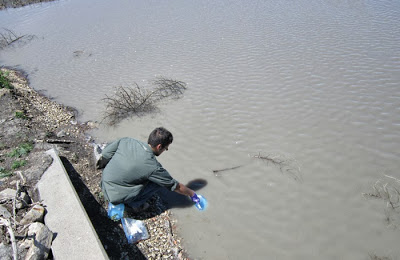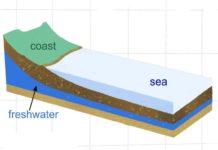
MANHATTAN — Two Kansas geologists are helping shed new light on how tungsten metal is leached from the sediment surrounding aquifers into the groundwater. The findings may have implications for human health.
Tungsten is a naturally occurring metal that is primarily used for incandescent light bulb filaments, drill bits and an alternative to lead in bullets. Though it is thought to be nonhazardous to the environment and nontoxic to humans, it can be poisonous if ingested in large amounts. In recent years, tungsten has been tentatively linked to cases of childhood leukemia in the Western U.S.
“Very little is known about the biogeochemistry of tungsten in the environment,” said Saugata Datta, professor of geology at Kansas State University. “We need to understand how this metal is leached from the soils into groundwater because humans can be exposed to tungsten through multiple pathways.”
Datta, along with Chad Hobson, master’s student in geology, Lavonia, Ga., and colleagues at Tulane University and the University of Texas, Arlington, found that the likelihood that tungsten will seep into an aquifer’s groundwater depends on the groundwater’s pH level, the amount of oxygen in the aquifer and the number of oxidized particles in the water and sediment. Analysis also showed that tungsten-VI is the most common form of tungsten in natural sediments.
These latest findings appear in the study “Controls on tungsten concentrations in groundwater flow systems: The role of adsorption, aquifer sediment Fe(III) oxide/oxyhydroxide content, and thiotungstate formation,” published in the journal Chemical Geology.
In addition to the publication, Datta and Hobson presented the findings at the International Conference on Biogeochemistry of Trace Elements.
For the study, researchers looked at Fallon, Nev.; Sierra Vista, Ariz.; and at the Cheyenne Bottoms Refuge near Hoisington, Kan. The sites were chosen based on previous studies analyzing plants and dust collected on trees in the locations. Additionally, these areas have natural tungsten mineral deposits, nearby military bases, and mining and smelting operations in the area, Datta said.
In 2002, the Centers for Disease Control investigated several clusters of acute lymphatic leukemia in both Nevada and Arizona. The investigation found that residents’ urine had tungsten levels above the 95th percentile.
“This was important for us to know because the goal is to clarify valuable information about tungsten’s geochemistry,” Datta said. “So, we needed sites that had tungsten — and enough tungsten to measure easily. The benefit of this study is that tungsten’s geochemistry has been overlooked and until recently, largely unknown. This work will help fill the gaps in the knowledge of tungsten, which is possibly carcinogenic, and help determine its future use.”
Datta and Hobson analyzed sediment samples lining the aquifers while researchers at Tulane University and the University of Texas, Arlington analyzed the groundwater samples. The National Synchrotron Light Source was used for spectroscopic analysis of the individual particles. This helped researchers understand the speciation of tungsten in natural sediments in the environment and helped them detect why tungsten forms organosulphur complexes that can be soluble in groundwater, Datta said. Analysis also showed that tungsten-VI is the most common form of tungsten in natural sediments.
Analysis of the sediment and groundwater showed that iron oxide and oxyhydroxide particles in both substances play a key role in regulating how much tungsten is in the groundwater. The fewer iron oxides or oxyhydroxide particles, the higher the amount of tungsten, Datta said.
Similarly, the team found that the number of tungsten-regulating iron oxide particles is controlled by the pH in the groundwater. A higher pH results in more tungsten entering the water.
“Tungsten is specifically bound to these iron oxides and oxyhydroxides,” Datta said. “One of the major factors controlling tungsten’s mobility and bioavailability is pH. Ranging values of pH can affect how tungsten behaves or transforms between different tungsten species, which have different properties and factors controlling mobility.”
When tungsten is in the water it is surrounded by oxygen atoms and forms an anion, Datta said. When in the presence of phosphates, this anion tends to bind with other transition metals, commonly iron, to form poloyoxometalates. In this form, tungsten can become more soluble in water.
Researchers also found that aquifers with less dissolved oxygen had greater traces of tungsten in the groundwater than aquifers with high dissolved oxygen levels.
The process of tungsten being leached from the surrounding sediment into the groundwater can be reduced if the ironoxides are in the water and the water has a neutral pH level, according to Datta.
The study is part of a three-year, $515,000 National Science Foundation-funded project between Kansas State University and Karen Johannesson at Tulane University that is titled “Collaborative Research: Chemical Hydrogeologic Investigations of Tungsten: Field, Laboratory, and Modeling Studies of an Emerging Environmental Contaminant.” It focuses on biogeochemistry of tungsten’s reaction to the environment and how it is transported from sediments into groundwaters once it becomes geochemically mobilized.
Note : The above story is based on materials provided by Kansas State University










